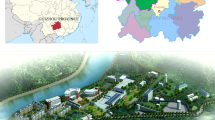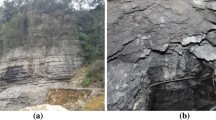As a kind of existing and potential geological disaster at the source of avalanche on cliffs or steep slopes, perilous rock has developed in the western area of China widely, and it has posed a serious threat to highways, railways, pipelines, cities, and mining for a long time. More than ten years of engineering experience have shown the necessity and importance to pay our attention to the avalanche sources in active collapse mitigation. The support–anchor combined technique is devoted to the active hazard mitigation measures of perilous rock. This paper introduces fracture mechanics to investigate the design procedure of the support–anchor combined technique. To obtain reasonable design parameters of the technique, both stability assessment criterion and three safety classes of protection engineering for perilous rock is proposed, further, stable analysis methods for various types of perilous rock are established by using fracture mechanics. Abiding by the idea that to improve stability coefficient to a higher level, the support force of structure and the anchorage force of anchorbolt from the support–anchor combined technique are introduced into stability analysis methods established above, which can estimate the section dimension of support subunit and the amount of anchorbolt of the technique. Engineering applications of the technique in thousands of protection engineering have identified the remarkable effectiveness
Similar content being viewed by others
References
F. V. D. Blasio, “Rheology of a wet, fragmenting granular flow and the riddle of the anomalous friction of large rock avalanches,” Granular Matter, 11, No. 3, 179–184 (2009).
H. K. Chen, H. M. Tang, and R. Wang, “Calculation method of stability for unstable rock and application to the Three Gorges Reservoir,” Chinese J. of Rock Mech. Eng., 23, No. 4, 614–619 (2004).
H. K. Chen, H. M. Tang, and S. Q. Ye, “Research on damage model of dominant fissure in perilous rock,” Appl. Math. Mech., 27, No. 7, 967–974 (2006).
H. K. Chen and H. M. Tang, “Method to calculate fatigue fracture life of dominant fissure in perilous rock,” Appl. Math. Mech., 28, No. 5, 643–649 (2007).
H. K. Chen, X. F. Xian, H. M. Tang, and Q. H. Feng, “A massive development mechanism and countermeasures for perilous rocks in the Three Gorges reservoir of P. R. China: the example of the Taibaiyan cliff at Wanzhou,” J. Chongqing Univ., 31, No. 10, 1178–1184 (2008).
H. K. Chen, X. F. Xian, H. M. Tang, and L. F. Wang, “Stability analysis method for perilous rock,” Chinese J. Appl. Mech., 26, No. 2, 278–282 (2009).
S. C. Cox and S. K. Allen, “Vampire rock avalanches of January 2008 and 2003, Southern Alps, New Zealand,” Landslides, 6, No. 2, 161–166 (2009).
G. B. Crosta and F. Agliardi, “Parametric calculation of 3D dispersion of rockfall trajectories,” Natural Hazards and Earth System Sciences, 4, 583–598 (2004).
L. K. A. Dorren, F. Berger, and U. S. Putters, “Real-size experiments and 3-D simulation of rockfall on forested and non-forested slopes,” Natural Hazards and Earth System Sciences, 6, No. 1, 145–153 (2006).
L. K. A. Dorren, B. Maier, U. S. Putters, and A. C. Seijmonsbergen, “Combining field and modeling techniques to assess rockfall dynamics on a protection forest hillslope in the European Alps,” Geomorphology, 57, No. 3–4, 151–167 (2004).
I. Manzella and V. Labiouse, “Qualitative analysis of rock avalanches propagation by means of physical modelling of non-constrained gravel flows,” Rock Mech. Rock Eng., 41, No. 1, 133–151 (2008).
A. L. Strom, “Rock avalanches of the Ardon River valley at the southern foot of the Rocky Range, Northern Caucasus, North Osetia,” Landslides, 1, No. 1, 237–241 (2004).
A. L. Strom and O. Korup, “Extremely large rockslides and rock avalanches in the Tian Shan mountains, Kyrgyzstan,” Landslides, 3, No. 2, 125–136 (2006).
H. M. Tang, L. F. Wang, H. K. Chen, and X. F. Xian, “Collapse sequence of perilous rock on cliffs with soft foundation,” Chinese J. Geotechn. Eng., 32, No. 2, 205–210 (2010).
P. Tommasi, P. Campedel, C. Consorti, and R. Ribacchi, “A discontinuous approach to the numerical modeling of rock avalanches,” Rock Mech. Rock Eng., 41, No. 1, 37–58 (2008).
O. M. Zambrano, “Large rock avalanches: A kinematic model,” Geotechn. Geol. Eng., 26, No. 3, 283–287 (2008).
Author information
Authors and Affiliations
Corresponding author
Additional information
Published in Prikladnaya Mekhanika, Vol. 49, No. 3, pp. 135–144, May–June 2013.
Rights and permissions
About this article
Cite this article
Chen, H.K., Tang, H.M. Study on the support–anchor combined technique to control perilous rock at the source of avalanche by fracture mechanics. Int Appl Mech 49, 369–378 (2013). https://doi.org/10.1007/s10778-013-0575-9
Received:
Published:
Issue Date:
DOI: https://doi.org/10.1007/s10778-013-0575-9




